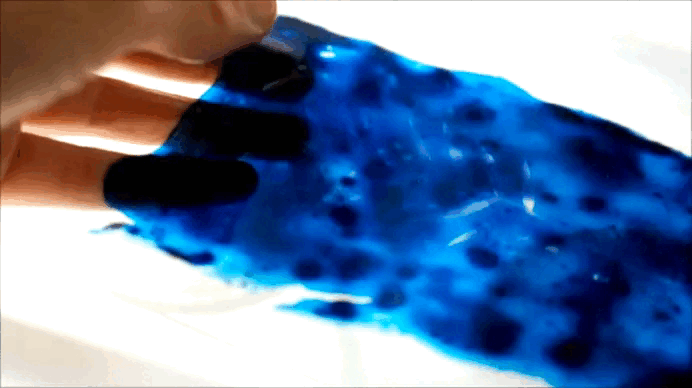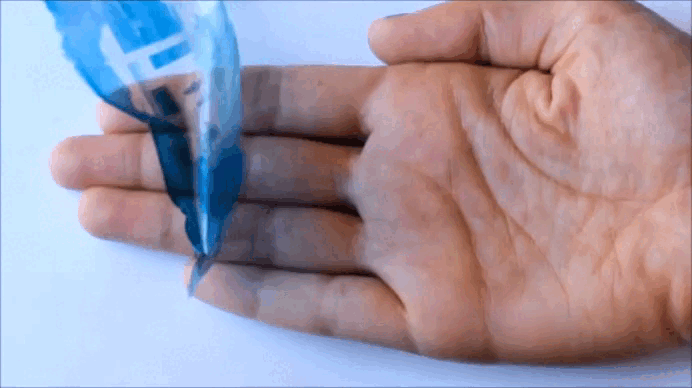Bioplastic in Printmaking
- Alternative Processes

- May 3, 2022
- 4 min read
Updated: Jan 19, 2023
With Dulce Delía
Dulce Delía is a photographer, educator and cyanotype artist.
Dulce talks about how as a child she liked to experiment, she would gather things from the bathroom and the kitchen and start mixing them together resulting in silly consistencies and funny smells. In her art practice she uses the cyanotype process on glass support. Given the non porous nature of glass, a substance is needed to make cyanotype adhere to the surfaces: in an attempt to avoid using gelatine made from bones and cartilage of animals she explores a more sustainable approach to printing, made of trials and errors.
This may sound time consuming and an extra step in your art practice, but if you Developing cyanotype in water using agar-agar as binder. are already an artist working with alternative processes you have made "What inspires me, apart from enjoying and peace with the amount of time and sharing experimentation and results of the patience that goes into making a piece. process, is thinking that in some moment, Here below is an interview with Dulce there could be a vegan option of photographic Delía where she goes through her process films, plates and papers on the market." of making Bioplastic.
What was the motivation behind working to create a substitute to animal based gelatine? What inspires you? When 2020 started, one of my goals was to print cyanotype on glass for the first time. I knew it was not going to be easy, so I started investigating. I soon realised something essential that felt like a big limitation: I was going to need gelatine in order to fix the emulsion to the glass. At that time I was also trying to become a vegetarian, so I didn’t feel comfortable using animal gelatine for this process. I began experimenting with free-range eggs, glue, aloe vera mucilage, but I wasn’t getting good results. I tried agar-agar, then linen seeds mucilage, then bioplastic. What inspires me, apart from enjoying and sharing experimentation and results of the process, is thinking that in some moment, there could be a vegan option of photographic films, plates and papers on the market. Cyanotype is the process I use more often, but these vegetable based gelatines can also be used with silver-halide based emulsions. Many people who love analogue photography nowadays are vegetarian. Producing vegan films could be an interesting market niche. Following @enrique_quique_martinez suggestion I started working with bioplastic. I discovered an unpredictable yet exciting substrate that works fine for cyanotype, has a strong personality, and blurs the line between photography and sculpture. The image and the substrate work together in expanding the possibilities of expression.
If I wanted to start making my own vegan bioplastic what do I need to start and what is the process? The first things you will need are patience and love for the process rather than the results. Trying to print on non-porous substrates requires more time than on paper, fabric or wood. It can take hours for the image to dry and often the results are not what you expected. It is however an opportunity to find new interesting ways to express yourself. If you want to use a non-animal binder, my advice to this day is to use agar-agar or homemade bioplastic. The first one is a vegetable based gelatine that comes from sea algae and it works as good as animal gelatine. The second one requires domestic-use substances as water, cornstarch, vinegar, and vegetable glycerine.
Ingredients for vegan bioplastic: (from left to right) water, vegetal glycerine, alcohol vinegar and cornstarch.
The ingredients and proportions needed in order to make bioplastic:
Cornstarch (24 g.)
Water (158 ml.)
White vinegar (15 ml.)
Vegan glycerine (15 ml.)
Mix everything with a spoon on the heat (as if you are making polenta, exactly the same), until it gets ointment consistency. Coat the glass surface with it while it's still hot and let it dry. Once dried, you can brush it with cyanotype emulsion. You can experiment with proportions and see what better woks for you.
Agar-agar and cyanotype layer after being Glass pieces coated with vegan bioplastic and cyanotype solution lifted from the glass. before sun exposure.
How long have you been experimenting on plant based gelatine and what are the main obstacles and problems you’ve encountered in making vegan bioplastic?
I’ve been investigating and experimenting since June 2020. I would say that the main obstacle that I’ve had until now is related to my education. I studied photography rather than chemistry or physics, so in many cases, my basic knowledge is insufficient. At some point I would love to be able to study it more to be able to better understand the results I get, and how to improve them or how to replicate them. I would also like to be part of an interdisciplinary group of researchers that look for alternatives to animal based gelatin.
The most important things in order to get a successful outcome with this process:
Resistance to water,
Good sharpness,
Good dynamic range.
The problems I encounter with the final outcome are the following:
Unpredictable textures,
Unpredictable bubbles,
Unpredictable forms,
Unpredictable breaks on the binder.
One may argue these flaws are also what makes the result interesting. Most of the time, I have embraced them and let the image speak through them. I like imperfections, I like the unpredictability of this kind of photography. In many cases, a piece can be unique and unrepeatable.
Cyanotype on agar-agar, removed from the glass and being Bioplastic, when it's very thin, reacts to the heat of
developed with water. touch, changing its form.
Currently I’m working on my first photographic series using vegan bioplastic. I work with traces of native vegetal species that were burned in the huge forest fires in Cordoba, Argentina, between July and October of 2020.
I am trying raise awareness regarding defence efforts and preservation of the native scrubland.
Alternative Processes Academy teaches you how to make bioplastic + ways of using it to create tangible pieces of work.
Author: Chiara Salvi
Photos by courtesy of the artist.















Comments